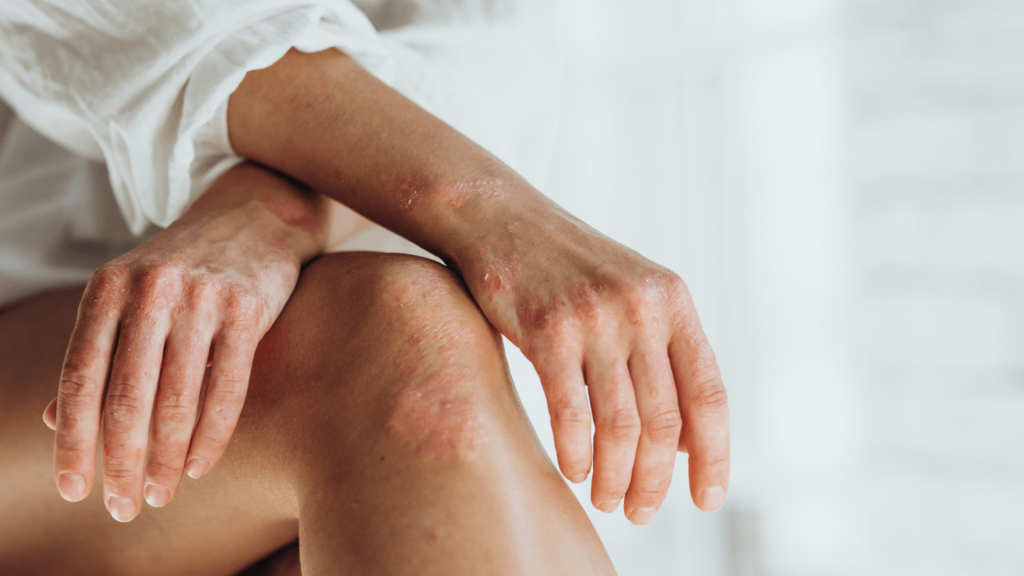Autoimmune diseases like Multiple Sclerosis (MS) and lupus occur when the immune system becomes unable to distinguish between external threats and the cells of the body, mistakenly attacking them instead. Those with autoimmune disease often experience flare-ups, in which their existing symptoms intensify or new symptoms emerge. Exercise, getting enough sleep, reducing stress, and quitting smoking are effective ways to manage autoimmune disease and prevent flare-ups.
Quick look
- Autoimmune disease (AD) occurs when the body’s immune system can’t differentiate between self and on-self—it starts attacking its own cells, tissues, and organs.
- Females are three times as likely to develop AD as males.
- Flare-ups are episodes in which existing autoimmune disease symptoms worsen, or new symptoms appear.
- Physical exercise can help reduce the symptoms of autoimmunity and help prevent flare-ups.
- An anti-inflammatory diet, getting enough sleep, reducing stress, and quitting smoking can also help you manage autoimmunity.
What is autoimmune disease?

The immune system is like your own personal army, ready to defend your body against external threats like infection and disease. Autoimmune disease occurs when those soldiers go rogue and start attacking your body’s own cells, organs, and tissues instead of foreign invaders—they cannot differentiate between self and non-self.
Autoimmune disease (AD), also sometimes referred to as an autoimmune disorder, is an umbrella term that includes over 80 different diseases, including rheumatoid arthritis, Type 1 diabetes, and lupus. The causes of AD are murky, but researchers know that females are almost three times as likely to develop it as males. Some environmental factors, such as childhood poverty, exposure to agricultural chemicals and organic mercury, and vitamin D levels, may also affect autoimmune diseases.
There is currently no known way to prevent autoimmune disease.
What are autoimmune flare-ups?
In addition to symptoms that are present every day, those with autoimmunity also frequently experience flare-ups, in which existing symptoms get much worse or new symptoms appear.
Flares can vary between individuals and differ between autoimmune disorders. Symptoms of a multiple sclerosis flare-up can include balance problems or dizziness, severe fatigue, numbness, tingling, or a feeling of pins and needles. Signs of a lupus flare might differ, including sores or ulcers in the mouth or nose, swollen legs, and fever. Those who have psoriasis might experience painful and inflamed lesions.
Flare-ups can be triggered by many different factors, including stress, diet, pregnancy, and even changing seasons. Managing these triggers and taking action to prevent flare-ups is crucial, especially when you need to feel your best on work sites or in the field.
Exercise for managing autoimmunity flare-ups

Flare-ups can be debilitating, causing immense pain and discomfort. For people in physical jobs, they can be a huge impediment to working There are several ways to prevent these episodes, and researchers have discovered that exercise is among the most effective strategies.
Recommending exercise as a way to mitigate autoimmunity flares can seem ironic, given that intense fatigue is one of the main symptoms of most autoimmune diseases. However, research shows that contrary to conventional belief, moving your body can make you less tired, not more.
In one 12-week study, female lupus patients walked on a treadmill three times a week for just 30 mins. At the end of the study, participants reported feeling “significantly less fatigue in their everyday lives than they had before, along with improved mental health and sleep.”
The authors found that not only did the patients report less fatigue, their bodies showed the same thing, with “evidence suggesting that exercise reduces lupus patients’ fatigue by improving the energy output of their cells’ mitochondria. The more that a participant’s mitochondria ramped up energy production after the 12 weeks of exercise training, the greater that person’s reduction in fatigue symptoms tended to be.”
A separate paper reviewing the clinical evidence about exercise’s impact on autoimmunity found that exercise led to improvements in most autoimmune diseases:
- Patients with rheumatoid arthritis had a “milder disease course, better cardiovascular disease (CVD) profile, and improved joint mobility.”
- In multiple sclerosis patients, physical exercise “decreases fatigue, enhances mood, cognitive abilities and mobility.”
- Patients with type 1 diabetes experienced “a decreased risk of autonomic neuropathy and CVD [cardiovascular disease.”
- Fibromyalgia and systemic sclerosis patients reported that the severity of their disease decreased, they experienced less pain, and they had a better quality of life when they participated in more physical activity.
Additionally, a 2024 meta-analysis examined existing research and concluded that exercise exerts an anti-inflammatory response in the body. Incorporating daily physical exercise into your routine is crucial to managing your condition and reducing the frequency of flare-ups (or eliminating them altogether).
Other natural methods for managing autoimmune flareups

Physical exercise is most effective in managing flare-ups when combined with other lifestyle changes, such as a healthy diet, adequate sleep, low stress, and quitting smoking.
Diet
Although each person will have individual dietary triggers, an anti-inflammatory diet is often recommended for those with autoimmune diseases. This approach reduces or eliminates common dietary sources of inflammation and encourages eating more anti-inflammatory foods. Harvard Health lists what to avoid and include to manage autoimmunity.
Inflammatory foods to reduce/eliminate:
- Refined carbohydrates (white bread, pastries)
- Fried foods
- Soda and other sugary drinks
- Red meat and processed meat
- Margarine, shortening, and lard
- Alcohol
Anti-inflammatory foods to include/increase:
- Tomatoes
- Olive oil
- Green, leafy vegetables like kale, lettuce, and collard greens
- Nuts
- Fatty fish like sardines, mackerel
- Fruits, especially blueberries, cherries, strawberries and oranges
Sleep
Research has shown that sleep is closely related to the immune system; lack of sleep can contribute to inflammation and immunodeficiency. Ensuring you get a good night’s sleep can help manage AD and reduce the severity of your flare-ups. Being well-rested when struggling with chronic fatigue from an autoimmune disease is especially important in construction, where you often work at heights, operate heavy machinery, and use dangerous tools.
To improve your sleep quality, install blackout blinds, keep your bedroom cool, play white noise, and establish a solid bedtime routine.
Reduce stress
While the link between stress and autoimmune disease isn’t yet clear, a study indicated that those with a stress-related disorder were more likely to be diagnosed with autoimmunity, more likely to develop multiple autoimmune diseases, and—if they were younger—had a higher rate of autoimmunity. Stress has also been associated with AD, including lupus, rheumatoid arthritis, inflammatory bowel disease, Graves Disease, and multiple sclerosis.
To reduce the likelihood of flares, keep your stress levels under control by practicing mindfulness, spending time in nature, or doing a low-stress activity to help you unwind.
Quit smoking
If you smoke, you know there are dozens of reasons you should quit, but now you can add AD flares to the list. Cigarette smoking has been linked to autoimmune diseases like rheumatoid arthritis, systemic lupus erythematosus, MS, Graves’ hyperthyroidism, and primary biliary cirrhosis.
Smoking causes inflammation throughout the body, and if you suffer from an autoimmune disease, quitting smoking can be a powerful tool to help manage flares and reduce the severity of your disease.
Bottom line
Living with an autoimmune disease can make you feel out of control—like someone else is at the steering wheel. You can regain control of your health and your life by taking concrete, actionable steps toward managing your disease and reducing flares. Exercise is one of the most powerful tools for minimizing the risk of AD flares. Combined with adequate sleep, low stress, and a nicotine-free life, you’ll give yourself your best chance at health and well-being.
Want more articles about how to stay healthy under the hard hat? Sign up for our newsletter and follow us on social media for practical tips ad advice.



